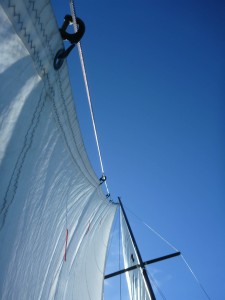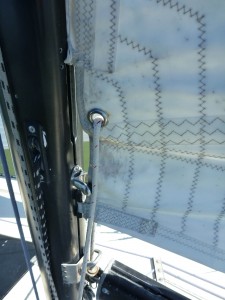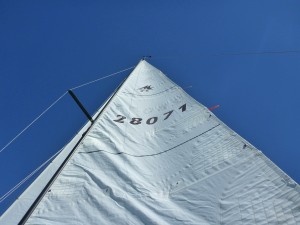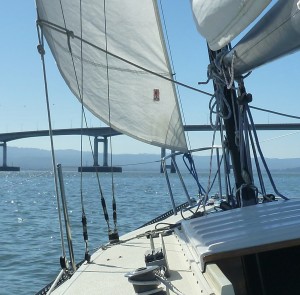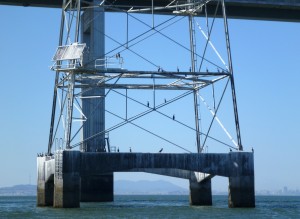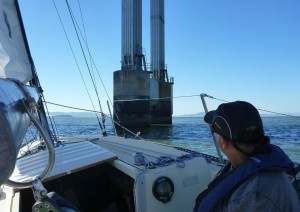We had an interesting sail yesterday, despite calm water and light winds. Amazing how every sail is different, even over the same, well-worn route!
To begin with, it was Port Fest in Redwood City, so the parking lot was full of cars and many people were walking around among the various displays. There was even a bouncy house!
Steve M. and I found parking right in front of the sailing school. I got there first, so I checked in the office to confirm which boat we would be on. Steve had reserved M-12, but Arjun had asked for M-12, so they bounced us to M-10. That’s fine, they’re all the same.
Except they’re not. When I got down to the slip, I remembered that M-10 is the last Merit in the fleet with a hanked-on jib and bolt-rope main. OK, no problem, I learned how to do that. So while I waited for Steve, I started setting up the boat.
Step one is always to start the motor, because it sometimes doesn’t. Step two is to take the pigtail off, because otherwise we forget. (The pigtail was already off this time, for some reason.) Then I started in on the jib.
In the cabin, I found two sail bags, both marked “Main.” I picked one arbitrarily and found it contained a jib with hanks. I didn’t check the other sail bag. I took the sail on deck and hooked the hanks on the forestay, taking care not to make the mistake I had last time (more than a year ago?) of hooking some hanks upside down, which doesn’t work at all.
As usual, two halyards emerge from the front of the mast, for jib and spinnaker. Naturally, I hooked up the wrong one first, but didn’t realize until I had raised the jib nearly to the masthead and saw the halyward wrapped around the forestay at the top. So I took the jib down, stowed the spinnaker halyard, and hooked up the jib halyard. It should have been obvious, since the jib halyward exits the mast below the forestay. I guess I need more practice to get it right the first time.
I went below to find jib sheets. There were four lines hanging up: Two matching green lines that looked too thin and too long, and two mismatched lines that looked like they might work, but one was thicker than necessary. Some of the boats with jib furlers have mismatched jib sheets, but it’s inconvenient when a jib sheet is too thick, as it binds in the fairleads.
So I took the matching lines on deck, tied them to the jib clew, and led them aft through the jib cars and fairleads. And, yep, they were far too long. So I stowed those and rigged the mismatched lines, which were about the right length. I raised the jib and left it up, as the winds were light, and I thought Steve should inspect my work, since he was the skipper for the day.
I got the rest of the boat set up and had just settled in to eat my sandwich when Steve arrived with the checklist and started checking out the boat. Just as I finished eating, I noticed the correct jib sheets neatly coiled and hanging from the stern pulpit. So I removed the mismatched lines and stowed them, then rigged the third set of sheets for the day.
Steve took the boat out of the slip and into the harbor. We found we were headed upwind, so I went forward and fed the mainsail bolt rope into the guide and then into the slot in the mast and raised the sail. It went up easily, with Steve back at the tiller taking in the slack on the halyard.
Once it was up, UGH, it looked awful, and it never got any better. The mainsail tack is attached several inches above the boom, leaving a large gap at the foot. We tightened the luff with the cunningham, but that pulls from well up the luff, so there was still a lot of slack in the foot, leaving much of the sail drooping and floppy. It never got any better. I’ll try to remember to ask Bob or Rich about that. Maybe they can tell me we were doing something wrong.
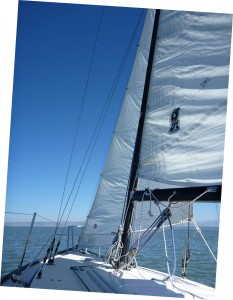
Note the raggedy main and the jib tacked down well inside the pulpit. I fixed the jib later, but there was no help for the main.
I raised the jib, and it looked happy, but when we let it out a bit, it draped over the bow pulpit, as always happens with the furling jibs. I stared at that for quite awhile, until an idea occurred to me later.
The wind was very light in the creek. We tried several times to sail, but in the end we motored out as far as the powerlines before we were able to start tacking down the channel.
At the end of the channel, Steve turned and sailed over to the red barrel. It was on that beam reach, as I looked at the jib draped over the pulpit, that I remembered there was a good twelve inches of halyard left at the top of the jib. So why leave the jib down in the pulpit, and the peak well below the masthead? So I went forward, dropped the jib just enough to take the tack off the hook, looped a dockline through the tack and down to the hook, and raised the jib up even with the top of the pulpit. That let the jib fly free, and we left it there through the rest of the sail!
From the red barrel, Steve tacked and sailed over to Marker 12, then handed the tiller off to me. I hove to for a few minutes, just for fun. It’s interesting to do that close (but not to close!) to a marker, to make it easier to judge drift.
Then I jibed to get moving again, then headed up to sail toward the San Mateo Bridge. Even with the light winds, it was soon apparent that we’d have no trouble sailing under the bridge before turning around and running back to the harbor before dark, so we kept on, with flat water and little heel.
I stayed on a port tack for quite awhile, to ensure we would make the center span of the bridge after just one tack. Approaching the causeway east of the high span, we tacked, and I was able to point well above the center span. I took a few fun photos as we approached the high span.
We sailed under the second span east of the high span, then bore away to the high span and bore away more to sail back under the bridge. After jibing to a very deep broad reach, we were pointing right at the east end of the Dumbarton bridge, several miles away, the landmark given us on our beginning course to stay safely out of the shallow water until the channel markers were in sight.
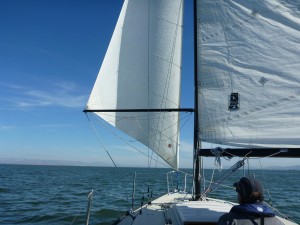
Zoom in to see that the camera distracted me, so I let the boat turn farther downwind than the east end of the Dumbarton, risking a accidental jibe. Good thing Steve had his head down!
Steve took the spinnaker pole forward and put the jib out on the windward side. Then he brought up our speed on the GPS and fiddled with the jib sheet until our speed maxed out at about 3.5 knots.
We sailed comfortably for close to an hour, gradually turning north as the wind changed, until we were pointed at the south end of Coyote Hills. Our track hardly changed at all, despite a gradual change of 10 degrees or so in heading. Soon, we could see we were tracking almost straight back to the red barrel, and we gradually picked out one after another of the channel markers.
When Marker 3 and Marker 5 lined up, we jibed and sailed straight toward the mouth of the channel on a beam reach. Steve took down the pole and stowed it below. We sailed back up the creek facing a bright, hot sun, noticing the tide was much lower than when we left.
In the harbor, I turned downwind to luff the jib, and Steve went forward to gather it in. He did a nice job of securing the jib in the pulpit by wrapping one of the jib sheets around it, then in a slip knot around the pulpit. I got the engine started with some difficulty. Twice we turned upwind to drop the mainsail, but had to turn around when the engine died to set up for another try.
Eventually, I got the hang of keeping the engine going, and we motored slowly upwind while Steve dropped the mainsail. Without the mast slides to hold the sail forward, it’s hard for one person to flake the main, but Steve did OK. At least it didn’t go in the water!
We motored back to the dock. I turned around and backed up the narrow fairway to the slip. I remembered the time I tried to motor into that slip forward, with a U turn at the end, but ran aground at low tide just off the slip, so I figured backing in was a better bet.
We took the jib off the forestay and laid it out on the dock to fold it. I could remember only part of that lesson, so I’m sure we didn’t get it folded exactly right, but at least we kept all the hanks on top for the next crew. We re-flaked the mainsail and put everything away.
It’s always fun to break out of the routine a bit. Many of us prefer the convenience of the jib furler and the mast slides, but I prefer some little challenges.
Steve, thanks for renting the boat!


